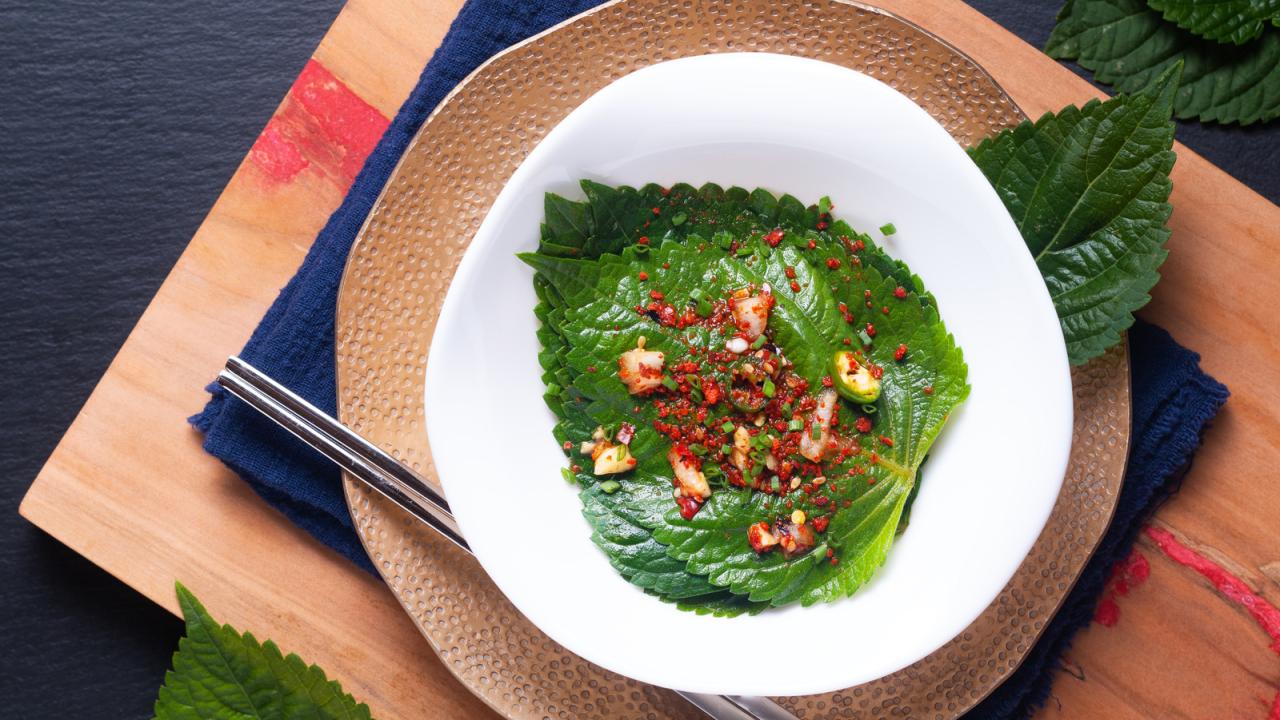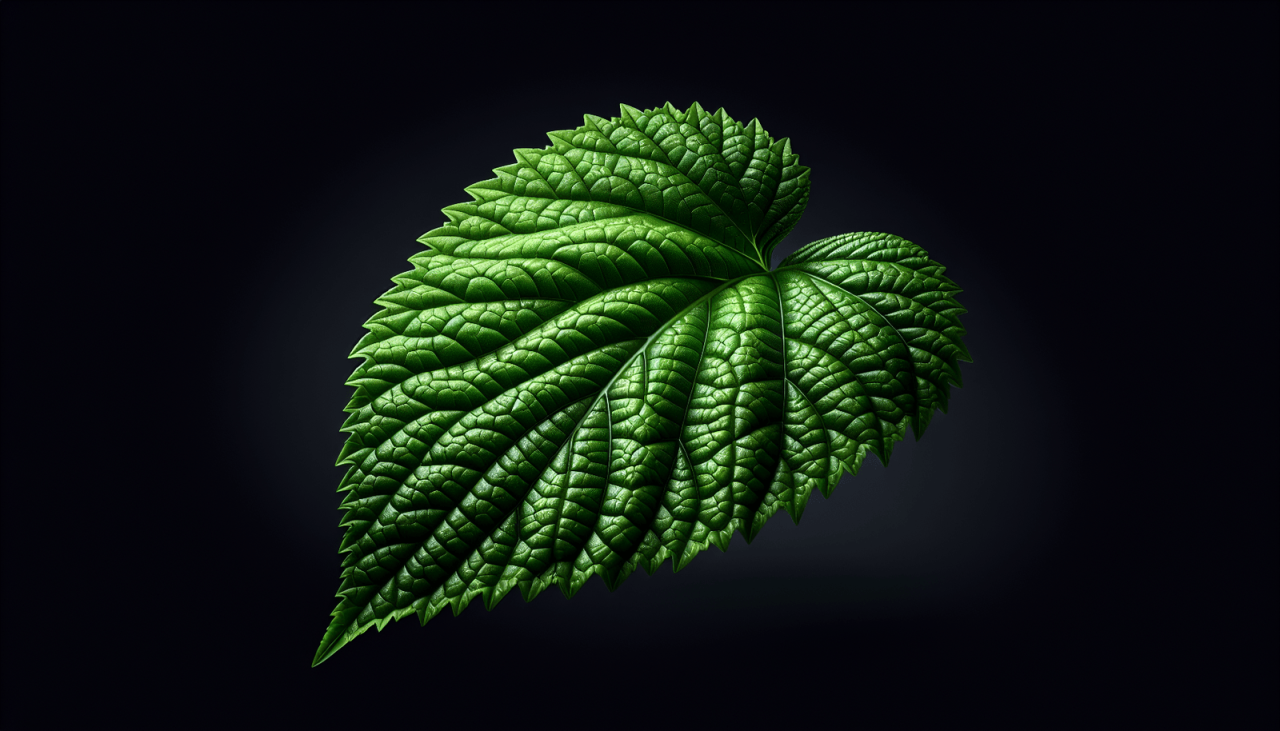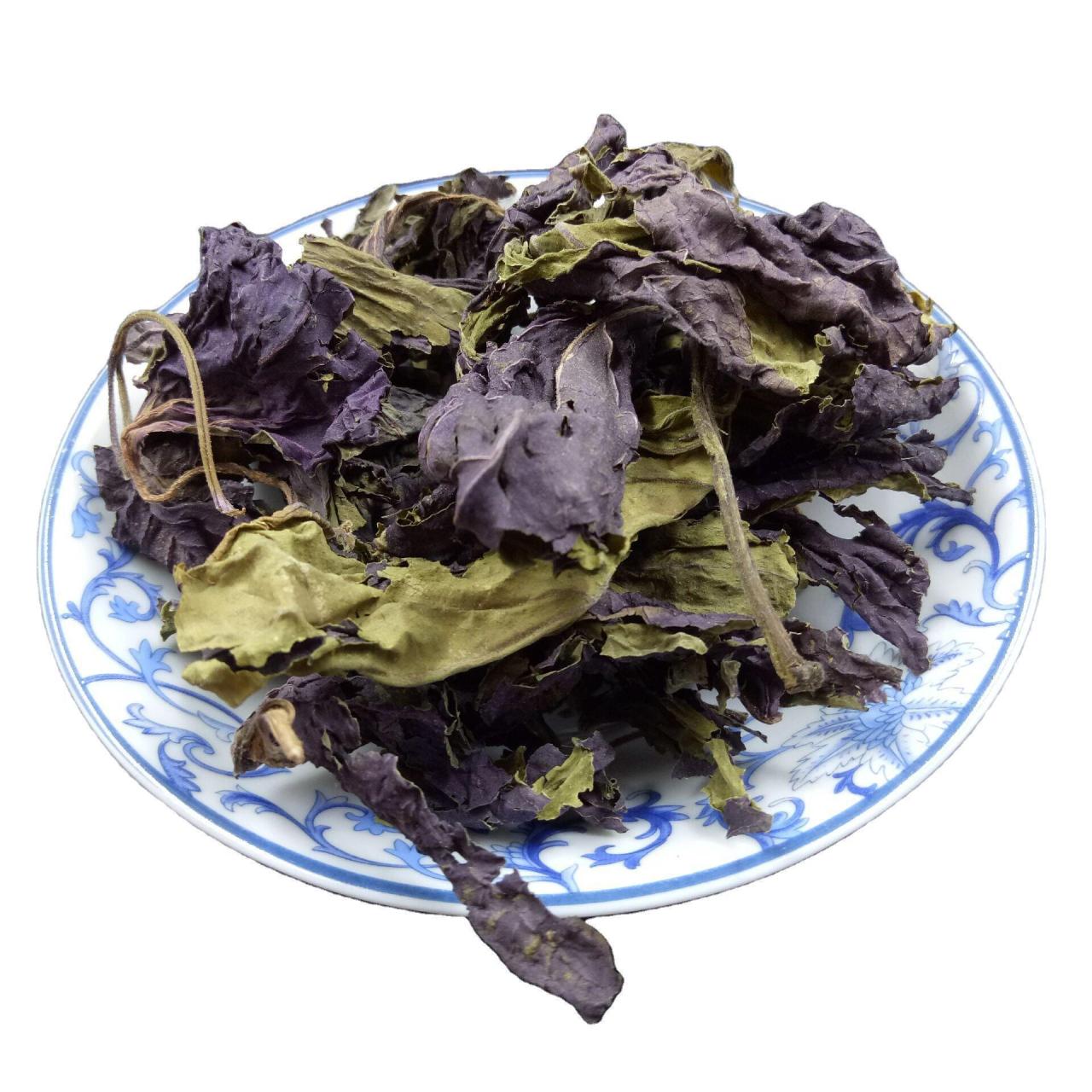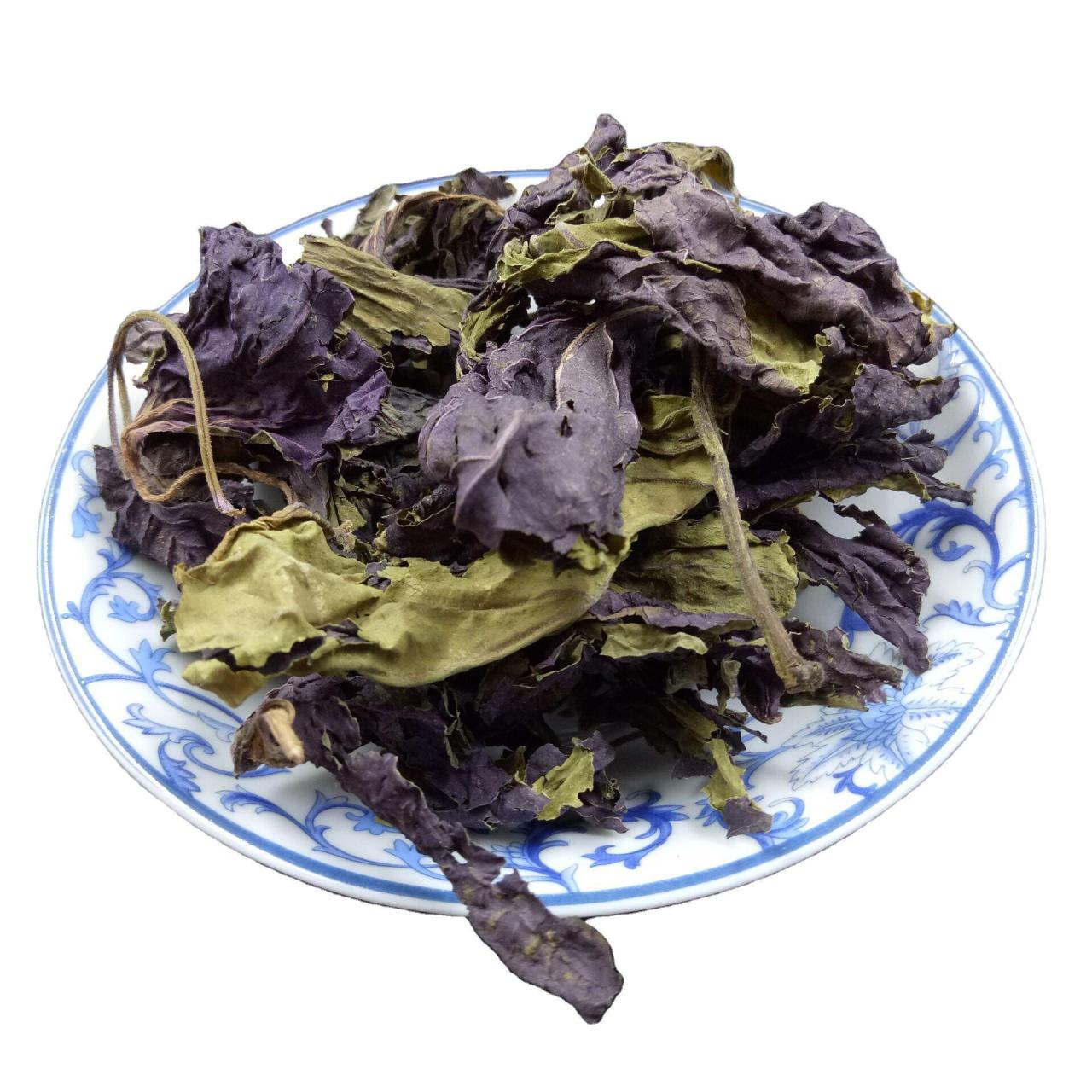Create Stunning Dishes with Perilla Leaf: How to Use This Herb for Amazing Flavor – Perilla leaf, also known as shiso, is a versatile herb with a unique flavor profile that can transform your culinary creations. From its distinctive aroma to its vibrant color, perilla leaf adds a touch of sophistication and intrigue to any dish.
This herb, often used in Asian cuisines, can be incorporated into salads, stir-fries, and even desserts, adding a burst of flavor and a touch of elegance.
Perilla leaf offers a spectrum of culinary possibilities, from its use in traditional Asian dishes to its ability to enhance the flavors of Western cuisine. Whether you’re a seasoned chef or a home cook looking to experiment with new flavors, perilla leaf is a versatile ingredient that can elevate your dishes to new heights.
Introduction to Perilla Leaf
Perilla leaf, also known as shiso, is a unique herb with a complex flavor profile that adds a distinct touch to various cuisines. Its versatility and nutritional benefits make it a valuable addition to any kitchen.
Flavor Profile
Perilla leaf possesses a distinctive, aromatic flavor that can be described as a blend of mint, basil, and citrus. Its taste can range from slightly sweet to pungent, depending on the variety and how it is prepared. Some varieties have a strong, almost licorice-like flavor, while others have a more delicate, citrusy note.
Versatility in Cuisines, Create Stunning Dishes with Perilla Leaf: How to Use This Herb for Amazing Flavor
Perilla leaf is a staple ingredient in various cuisines around the world. It is commonly used in:
- Japanese cuisine:Perilla leaf, known as shiso in Japan, is a popular ingredient in sushi, tempura, and other dishes. It is often used as a garnish or wrapped around food to add flavor and aroma.
- Korean cuisine:In Korean cuisine, perilla leaf is known as “kkeut” and is often used as a condiment or wrap for grilled meats. It is also used in kimchi, a fermented cabbage dish.
- Chinese cuisine:Perilla leaf is used in Chinese cooking, especially in the Sichuan region. It is used to flavor stir-fries, soups, and other dishes.
- Southeast Asian cuisine:Perilla leaf is also found in Southeast Asian cuisine, where it is used in salads, curries, and other dishes.
Nutritional Benefits
Perilla leaf is not only flavorful but also a nutritious herb. It is a good source of:
- Antioxidants:Perilla leaf is rich in antioxidants, which help protect the body from damage caused by free radicals.
- Essential fatty acids:Perilla leaf contains alpha-linolenic acid (ALA), an omega-3 fatty acid that is important for heart health.
- Vitamins and minerals:Perilla leaf is also a good source of vitamins A, C, and K, as well as minerals like iron and calcium.
Culinary Uses of Perilla Leaf
Perilla leaf, with its unique aroma and versatility, is a culinary gem, especially in Asian cuisines. Its flavor profile, ranging from minty and citrusy to slightly peppery, adds depth and complexity to dishes.
Perilla leaf, with its vibrant green hues and unique flavor profile, can transform your culinary creations. Just like the vibrant colors of autumn leaves inspire a beautiful autumn leaf garland , this herb adds a touch of artistry to your dishes.
Whether you’re adding a pop of color to a salad or infusing your stir-fries with a distinct aroma, perilla leaf is a versatile ingredient that can elevate your culinary game.
Incorporating Perilla Leaf into Dishes
Perilla leaf’s distinct flavor makes it a perfect ingredient for various culinary applications.
- Salads:Its fresh, vibrant flavor complements the crispness of greens. Use perilla leaf in salads for a refreshing twist, adding a unique aroma and flavor.
- Stir-fries:Perilla leaf’s heat-resistant nature makes it ideal for stir-fries. Add it towards the end of cooking to retain its vibrant color and flavor.
- Wraps and Rolls:Its aromatic leaves can be used as wraps for various fillings, adding a distinct flavor to sushi rolls, spring rolls, and other similar dishes.
- Soups and Stews:Perilla leaf can be added to soups and stews to enhance their flavor and aroma. Its distinct flavor blends well with various broth bases and ingredients.
- Dips and Sauces:Perilla leaf can be incorporated into dips and sauces for a unique flavor twist. It can be finely chopped and added to sauces like pesto, chimichurri, or even used as a garnish for a touch of freshness.
- Meat and Fish Dishes:Perilla leaf’s peppery notes pair well with grilled, roasted, or pan-fried meats and fish. It can be used as a garnish, added to marinades, or incorporated into sauces to enhance the dish’s flavor profile.
Perilla Leaf Preparations and Flavor Profiles
Preparation |
Flavor Profile |
|---|---|
Fresh Leaves |
Minty, citrusy, slightly peppery |
Dried Leaves |
Intensified flavor, more pronounced peppery notes |
Infused Oil |
Aromatic oil with hints of mint and citrus |
Pickled Leaves |
Tangy, slightly sweet, and aromatic |
Powdered Leaves |
Concentrated flavor, can be used as a seasoning |
Preparing Perilla Leaf for Cooking

Perilla leaf is a versatile herb that can be used in a variety of dishes, but it’s important to prepare it correctly to maximize its flavor and freshness. Proper storage and preservation are key to ensuring that you have this unique herb readily available for your culinary creations.
Storing and Preserving Perilla Leaf
Storing and preserving perilla leaf correctly is crucial for maintaining its flavor and freshness.
- Refrigeration:The most common method is to store perilla leaves in the refrigerator. Wrap them loosely in a paper towel or a clean kitchen towel and place them in a plastic bag. Store them in the crisper drawer of your refrigerator, where they can last for up to a week.
- Freezing:To preserve perilla leaf for longer periods, you can freeze it. Wash and dry the leaves thoroughly. Then, stack them in a freezer-safe bag, removing as much air as possible before sealing. Frozen perilla leaf can last for several months.
- Drying:Drying perilla leaves is another way to preserve them. You can air-dry them in a well-ventilated area, out of direct sunlight. Alternatively, you can use a food dehydrator. Dried perilla leaves can be crumbled and used as a seasoning or stored in airtight containers for up to a year.
Perilla leaf, with its unique flavor profile and vibrant color, can elevate any dish. From salads to stir-fries, this herb adds a touch of complexity and freshness. While you’re exploring culinary creativity, consider the ease of propagating your own herbs – like ivy, for example.
Learn how to create a lush, vibrant garden with How to Propagate Ivy Like a Pro: The Foolproof Guide. With a thriving herb garden, you’ll have an endless supply of fresh ingredients for your next perilla-infused masterpiece.
Cleaning and Preparing Perilla Leaf
Before using perilla leaf in your dishes, it’s essential to clean it properly.
- Washing:Rinse the leaves under cool running water, ensuring you remove any dirt or debris. Gently pat them dry with a clean kitchen towel.
- Removing Stems:If using whole leaves, you can remove the stems by pinching them off at the base. However, for dishes where the leaves will be chopped or minced, you can leave the stems on, as they add a slightly bitter flavor that can be desirable in some recipes.
Incorporating Perilla Leaf into Dishes
Perilla leaf can be used in a variety of ways, depending on the dish and your desired flavor profile.
- Chopping:Finely chop perilla leaves to add a vibrant, herbaceous flavor to salads, stir-fries, and sauces.
- Mincing:Mince perilla leaves for a more concentrated flavor, ideal for incorporating into dips, marinades, and dressings.
- Whole Leaves:Use whole perilla leaves as a garnish for sushi, noodles, or rice dishes.
Recipes Featuring Perilla Leaf

Perilla leaf, with its unique flavor and versatility, can be incorporated into a wide range of dishes. From simple salads to flavorful stir-fries, this herb can elevate the taste of your culinary creations. Here are some recipes that highlight perilla leaf as a key ingredient.
Simple Perilla Leaf Salad with Citrus Vinaigrette
This refreshing salad is a perfect way to showcase the delicate flavor of perilla leaf.
Ingredients:
- 1 cup mixed greens
- 1/2 cup perilla leaves, thinly sliced
- 1/4 cup cherry tomatoes, halved
- 1/4 cup cucumber, thinly sliced
- 1 tablespoon olive oil
- 1 tablespoon lemon juice
- 1 teaspoon honey
- Salt and pepper to taste
Instructions:
- In a large bowl, combine the mixed greens, perilla leaves, cherry tomatoes, and cucumber.
- In a small bowl, whisk together the olive oil, lemon juice, honey, salt, and pepper.
- Pour the vinaigrette over the salad and toss to coat.
- Serve immediately.
Flavorful Perilla Leaf Stir-Fry with Tofu and Vegetables
This stir-fry combines the savory notes of perilla leaf with the protein of tofu and the freshness of vegetables.
Ingredients:
- 1 block firm tofu, pressed and cubed
- 1 tablespoon vegetable oil
- 1/2 cup sliced onion
- 1 cup sliced bell pepper
- 1 cup sliced mushrooms
- 1/2 cup perilla leaves, chopped
- 1/4 cup soy sauce
- 1 tablespoon honey
- 1 teaspoon sesame oil
- 1/2 teaspoon ground ginger
- Salt and pepper to taste
Instructions:
- Heat the vegetable oil in a large skillet or wok over medium heat.
- Add the tofu and cook until browned on all sides.
- Add the onion, bell pepper, and mushrooms to the skillet and cook until softened, about 5 minutes.
- Stir in the perilla leaves, soy sauce, honey, sesame oil, and ginger.
- Cook for 1 minute more, or until the sauce has thickened.
- Season with salt and pepper to taste.
- Serve hot over rice or noodles.
Recipes Highlighting Perilla Leaf as a Key Ingredient
Perilla leaf can be incorporated into a variety of dishes, adding a unique flavor profile to your culinary creations. Here are some recipes that feature perilla leaf as a key ingredient:
- Perilla Leaf Kimchi:This spicy and fermented Korean side dish is made with perilla leaves, chili peppers, garlic, and other seasonings.
- Perilla Leaf Pesto:This flavorful pesto is made with perilla leaves, garlic, pine nuts, and Parmesan cheese. It can be used as a sauce for pasta, as a spread for sandwiches, or as a topping for grilled meats and vegetables.
- Perilla Leaf Tea:This refreshing tea is made by steeping perilla leaves in hot water. It is known for its calming and digestive properties.
- Perilla Leaf Pancakes:These savory pancakes are made with a batter of perilla leaves, flour, and eggs. They can be served with a variety of dipping sauces, such as soy sauce, chili sauce, or honey.
- Perilla Leaf Soup:This flavorful soup is made with a broth of perilla leaves, vegetables, and meat or tofu. It is a hearty and comforting meal that is perfect for a cold day.
Perilla Leaf’s Role in Flavor Enhancement: Create Stunning Dishes With Perilla Leaf: How To Use This Herb For Amazing Flavor

Perilla leaf, with its unique flavor profile, is a versatile ingredient that can elevate the taste of various dishes. Its distinct aroma and taste can add depth and complexity to both sweet and savory culinary creations. Understanding the nuances of perilla leaf’s flavor and how it interacts with other ingredients is crucial for harnessing its potential as a flavor enhancer.
Comparing and Contrasting Perilla Leaf’s Flavor Profile
Perilla leaf’s flavor is often described as a blend of minty, citrusy, and slightly spicy notes. It possesses a refreshing quality that can cut through rich or heavy flavors, adding a bright and vibrant element to dishes. Perilla leaf’s flavor profile can be compared and contrasted with other herbs based on its dominant flavor notes:
- Mint:Perilla leaf shares a similar minty freshness with mint, but it has a more complex flavor with hints of citrus and spice. This makes it a good substitute for mint in some dishes, particularly those with Asian influences.
- Basil:While both perilla leaf and basil have a slightly sweet and herbaceous flavor, perilla leaf is more pungent and has a distinct citrusy undertone. It can be used to add a unique twist to dishes that traditionally call for basil.
- Shiso:Perilla leaf is closely related to shiso, another Asian herb. Both have a similar flavor profile, but shiso is generally milder and sweeter. Perilla leaf is often used as a substitute for shiso in dishes where a more pronounced flavor is desired.
Tips for Using Perilla Leaf to Create Balanced and Complex Flavor Profiles
Perilla leaf’s versatility allows it to be used in various ways to enhance the flavor of dishes. Here are some tips for incorporating perilla leaf into your culinary creations:
- Use perilla leaf in marinades and sauces:Its unique flavor can infuse meats, fish, and vegetables with a vibrant and refreshing taste. For example, a marinade for grilled chicken or fish can be enhanced with a blend of perilla leaf, soy sauce, ginger, and garlic.
- Add perilla leaf to stir-fries and noodle dishes:Its aromatic qualities can add depth and complexity to stir-fries, while its refreshing taste can balance out the richness of noodle dishes.
- Use perilla leaf as a garnish:Its vibrant green color and distinctive flavor can add a finishing touch to salads, soups, and sushi.
- Infuse perilla leaf in oil or vinegar:This can create a flavorful condiment that can be used to dress salads, drizzle over grilled dishes, or add a unique touch to sauces.
- Experiment with perilla leaf in desserts:Its refreshing and slightly sweet flavor can complement fruity desserts and add a unique twist to traditional sweets.
Visual Appeal of Perilla Leaf Dishes
Perilla leaf, with its vibrant hues of green, purple, and red, adds a striking visual element to any dish. Its unique color palette can transform a simple plate into a culinary masterpiece, captivating the eye and enhancing the overall dining experience.
Garnishing and Plating Techniques
The versatility of perilla leaf allows for creative garnishing and plating techniques. Its delicate texture and vibrant color make it an ideal choice for adding a touch of elegance to dishes.
- Adding Color and Texture:Perilla leaf can be used as a colorful garnish to enhance the visual appeal of dishes. For example, a sprinkle of shredded perilla leaf can add a pop of color to a simple salad or soup.
- Creating Visual Interest:Perilla leaf can be arranged artistically on the plate to create visual interest. For example, a few sprigs of perilla leaf can be placed around a plate of grilled fish, adding a touch of freshness and sophistication.
- Complementary Colors:The vibrant colors of perilla leaf can be used to create complementary color schemes on the plate. For example, a dish of white rice with red perilla leaf would create a striking visual contrast.
“The vibrant color of perilla leaf can transform a simple plate into a culinary masterpiece, captivating the eye and enhancing the overall dining experience.”
Final Thoughts
Perilla leaf, with its unique flavor and vibrant color, is a culinary treasure waiting to be discovered. From adding depth to salads to enhancing the complexity of stir-fries, perilla leaf offers a world of flavor possibilities. Embrace its versatility and explore its potential in your own kitchen, creating dishes that are both delicious and visually appealing.
So, venture beyond the ordinary and add a touch of perilla leaf magic to your culinary repertoire.
Common Queries
What does perilla leaf taste like?
Perilla leaf has a unique flavor profile that can be described as a blend of mint, basil, and citrus, with a hint of spice. The flavor can vary depending on the variety of perilla leaf, with some varieties having a more pronounced minty or citrusy flavor.
Where can I find perilla leaf?
Perilla leaf is available at Asian grocery stores, specialty markets, and some larger supermarkets. It can also be grown at home, either from seeds or seedlings.
Can I substitute perilla leaf with another herb?
While perilla leaf has a unique flavor, you can substitute it with other herbs such as mint, basil, or cilantro if needed. However, the flavor profile will differ significantly.
How long does perilla leaf last?
Fresh perilla leaf can be stored in the refrigerator for up to a week. To preserve perilla leaf for longer, you can freeze it or dry it.
